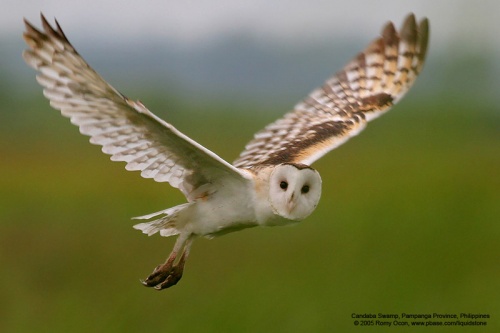m (Eastern Grass-Owl moved to Eastern Grass Owl) |
(Photo caption. Taxonomy, References) |
||
| Line 1: | Line 1: | ||
| − | |||
'''Alternative names: Australasian Grass-Owl; Australian Grass-Owl''' | '''Alternative names: Australasian Grass-Owl; Australian Grass-Owl''' | ||
| + | [[Image:African_Grass_Owl.jpg|thumb|500px|right|Photo by {{user|Romy+Ocon|Romy Ocon}} <br /> Candaba Swamp, Pampanga, [[Philippines]], August 2005]] | ||
| + | |||
;[[:Category:Tyto|Tyto]] longimembris | ;[[:Category:Tyto|Tyto]] longimembris | ||
==Identification== | ==Identification== | ||
| − | Female: 35-38cm Male: 32-36cm | + | Female: 35-38cm Male: 32-36cm<br /> |
| − | |||
*Dark brown above, pale spots | *Dark brown above, pale spots | ||
*Cream or buff below with brown spots | *Cream or buff below with brown spots | ||
| Line 18: | Line 18: | ||
==Taxonomy== | ==Taxonomy== | ||
Until recently, the Eastern Grass Owl was considered to be part of [[African Grass Owl]] which at that time was known only as "Grass Owl". | Until recently, the Eastern Grass Owl was considered to be part of [[African Grass Owl]] which at that time was known only as "Grass Owl". | ||
| − | + | ====Subspecies==== | |
| − | There are | + | There are 6 subspecies<sup>[[#References|[1]]]</sup>: |
| + | *T. l. longimembris'': | ||
| + | :*[[India]] to [[Indochina]], [[Sulawesi]], [[Lesser Sundas]], northern and eastern [[Australia]] | ||
| + | *T. l. chinensis'': | ||
| + | :*South-eastern [[China]] (south-eastern Yunnan to Jiangsu) and [[Vietnam]] | ||
| + | *T. l. pithecops'': | ||
| + | :*[[Taiwan]] | ||
| + | *T. l. amauronota'': | ||
| + | :*[[Philippines|Philippine Islands]] | ||
| + | *T. l. baliem'': | ||
| + | :*Western [[New Guinea]] | ||
| + | *T. l. papuensis'': | ||
| + | :*Montane grasslands of eastern New Guinea | ||
==Habitat== | ==Habitat== | ||
| − | + | Grasslands, canefields and paddy Fields. | |
==Behaviour== | ==Behaviour== | ||
Nocturnal. | Nocturnal. | ||
| − | + | ====Diet==== | |
The diet includes rodents. | The diet includes rodents. | ||
| − | + | ====Breeding==== | |
| − | They are ground nesters, building the platform nest from grass in dense tussocks of grass or sedges | + | They are ground nesters, building the platform nest from grass in dense tussocks of grass or sedges. The 3-8 dull white eggs are incubated for about 42 days. The young fledge at about 2 months. |
==References== | ==References== | ||
| − | Owlpages | + | #{{Ref-Clements6thAug11}}#Owlpages |
| + | {{ref}} | ||
==External Links== | ==External Links== | ||
{{GSearch|Tyto+longimembris}} | {{GSearch|Tyto+longimembris}} | ||
[[Category:Birds]] [[Category:Tyto]] | [[Category:Birds]] [[Category:Tyto]] | ||
Revision as of 21:51, 23 July 2012
Alternative names: Australasian Grass-Owl; Australian Grass-Owl
- Tyto longimembris
Identification
Female: 35-38cm Male: 32-36cm
- Dark brown above, pale spots
- Cream or buff below with brown spots
- Buff wing bars
- White facial disc
- Brown mark in front of each eye
- Brown iris
- Pale brown bill
- Very long feathered legs
- Grey feet
Distribution
India to southeast Asia, Philippines, and Australia.
Taxonomy
Until recently, the Eastern Grass Owl was considered to be part of African Grass Owl which at that time was known only as "Grass Owl".
Subspecies
There are 6 subspecies[1]:
- T. l. longimembris:
- India to Indochina, Sulawesi, Lesser Sundas, northern and eastern Australia
- T. l. chinensis:
- T. l. pithecops:
- T. l. amauronota:
- T. l. baliem:
- Western New Guinea
- T. l. papuensis:
- Montane grasslands of eastern New Guinea
Habitat
Grasslands, canefields and paddy Fields.
Behaviour
Nocturnal.
Diet
The diet includes rodents.
Breeding
They are ground nesters, building the platform nest from grass in dense tussocks of grass or sedges. The 3-8 dull white eggs are incubated for about 42 days. The young fledge at about 2 months.
References
- Clements, JF. 2011. The Clements Checklist of Birds of the World. 6th ed., with updates to August 2011. Ithaca: Cornell Univ. Press. ISBN 978-0801445019. Spreadsheet available at http://www.birds.cornell.edu/clementschecklist/downloadable-clements-checklist
- Owlpages
Recommended Citation
- BirdForum Opus contributors. (2024) Eastern Grass Owl. In: BirdForum, the forum for wild birds and birding. Retrieved 10 May 2024 from https://www.birdforum.net/opus/Eastern_Grass_Owl




